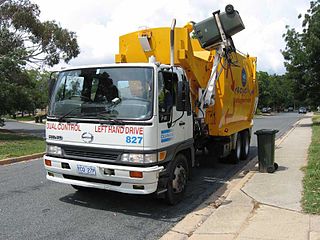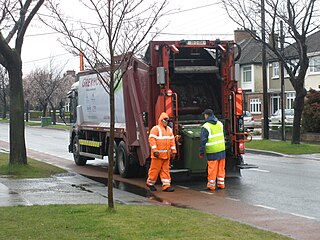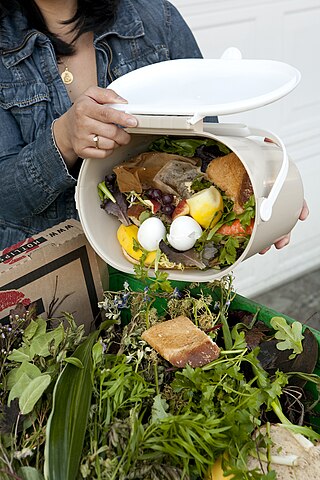History
Early 1900s
The roots of San Francisco's recycling and composting program can be traced back to the formation of the Scavengers Protective Union in 1879, when loose federations of scavengers began. Most were Italian immigrants from one region of Italy and they hauled municipal waste in horse-drawn wagons and hand-separated valuable discards for resale. [4] [5] The scavengers made a living from materials similar to those salvaged in recycling programs today such as wood, metals, glass, rags, yard trimmings and food residuals. [4] At that time, some of the materials were used as fuel, others were recycled and the yard debris and food residuals were sold to hog farmers in the outlying neighborhoods of the city for use as animal feed.
In 1921, the city began regulating waste collection and around the same time, scavengers, who were fiercely competing for the same materials, began forming associations. Rates were set under the 1932 ordinance, and required voter approval to change. This was modified by an amendment to the 1932 ordinance, approved by the voters in 1954 and effective in 1955, which established a rate adjustment system managed by city staff.
Cooperation amongst the former rivals allowed them to pool their resources. [6] The two loose associations became known as Scavenger's Protective Association and Sunset Scavenger Company. These two entities eventually merged, and as a result all of the permits issued by the city came to be held by one entity. Exclusive refuse collection licenses for the city were issued in 1932—licenses still held today under the parent company, Recology. [6] [7] This steadfast relationship between the city and Recology San Francisco has resulted in a reliable public-private partnership, allowing San Francisco to design experimental pilot programs such as city-wide curbside organics collection. [7]
1950s–1970s
Although San Francisco has the highest diversion rate amongst all large cities in the United States today, [7] in the late 1950s, the advent of packer trucks forced the city's recycling rate to an all-time low. Because separation of compacted materials was unfeasible, by 1967 Sunset Scavenger company and Golden Gate Disposal had scaled back their recycling operations to a mere two programs, metals and paper recycling. [5] However, the 1970s brought a renewed interest in resource conservation. The federal Clean Air Act and Clean Water Act were signed into legislation and the first Earth Day celebration was held on April 22, 1970. In the spirit of these times, San Francisco residents proactively organized to create new volunteer-run community recycling centers. By 1980, San Francisco had a total of ten community recycling centers, offering residents the opportunity to recycle their newspaper, glass and cans. [5]
1980s–1990s

In 1980, under the city's chief administrative officer, the San Francisco Recycling Program (SFRP) was developed as a division of the Solid Waste Management Program. The goal of the SFRP was to facilitate and develop recycling programs throughout the city. After receiving a grant from the state in 1981, the city established three buy-back centers and launched its first curbside recycling program. With the passage of California's Bottle Bill (AB2020) in 1986, all community recycling centers in San Francisco began offering monetary compensation for materials with a California Redemption Value.
While this initial curbside recycling collection was unsuccessful due to scavengers, San Francisco continued to promote recycling efforts. The city formed an advisory council to help design another residential curbside pilot and collaboratively started two new programs targeting bar and restaurant glass collection and city government office paper recycling. [5] In 1988, San Francisco's Solid Waste Management Program set diversion goals, calling for a 32 percent reduction in the city's waste stream by 1992 and 43 percent by 2002. However, in 1989, the California legislature preempted San Francisco's goals by passing the Integrated Waste Management Act (AB 939), which set waste reduction goals of 25 percent by 1995 and 50 percent by 2000. The city's diversion goals were amended shortly after to reflect the new state requirements. [5]
By 1989, the city had begun a series of new curbside pilot programs, collecting mixed paper and containers (glass, aluminum and plastic). [8] This program was fully operational by 1991, and contributed to San Francisco's achievement of 27 percent diversion in 1990. [5] By 1997, the program had led to an additional 15,500 tons of recyclables diverted, yet a 1996 waste characterization study illustrated additional opportunities for reaching AB939 goals. According to the study, 60,000 tons of unrecovered recyclables remained in the waste stream, 26 percent of which were food residuals. Because San Francisco is a dense city, yard waste was found to make up only 5 percent of the residential waste stream. These findings, in conjunction with AB939 diversion requirements, prompted San Francisco to develop new curbside recycling pilots that included the collection of food residuals. [8]
Pilot programs are commonly used as a mechanism for determining prospective infrastructure investments and educational tactics including, "collection containers, vehicles, outreach needs, processing needs and the impact of neighborhoods with different demographics." [9] In 1999, San Francisco and Recology rolled out their most recent pilot, a dedicated color-coded cart system called the Fantastic Three. [10] The color-coded cart system was designed to make recycling and composting easy for residents, with each color signifying the type of materials accepted (blue=recycling, green=organics, black=landfill). The Fantastic Three also integrated financial incentives for participation. The program's pay as you throw framework allowed residents and businesses to reap savings as their trash volumes decreased. [9] Within seven months, the Fantastic Three helped to increase diversion by more than 90 percent amongst participating businesses and residents and generated a 73 percent satisfaction rating. [9] [10] With this success rate, Recology, in collaboration with the city, invested in a plan to further expand the program. [9]
2000s to present
Having invested in the infrastructure to increase the diversion of organics and recyclables from landfills, San Francisco realized a 50 percent diversion rate shortly after the Fantastic Three program was officially introduced. However, the city decided to pursue higher diversion rates than those required by the state for several reasons. First, the 1997 Sustainability Plan adopted by the Board of Supervisors included a long-term goal "to maximize sustainable uses of natural resources and to eliminate solid waste generation in the City and County of San Francisco." [11] Additionally, Alameda County adopted Measure D which, "set a goal of achieving a 75 percent waste diversion rate by 2010 and as a condition of the Waste Disposal Agreement for disposing San Francisco waste in the Altamont Landfill in Alameda County, the City was required to recycle or divert waste at the same or greater level than that of East Bay (Alameda County) jurisdictions using the Altamont landfill." [11] As a result, the Board of Supervisors passed the Zero Waste Goal (Resolution No. 007-02-COE) in 2002, requiring San Francisco to divert 75 percent of its waste by 2010 and to achieve zero waste by 2020. [11]
While the city's investment in the Fantastic Three program demonstrated its ability to achieve high diversion rates and encouraged the creation of new goals, the Zero Waste resolution built the framework from which new waste reduction legislation could be drafted. Shortly after the Zero Waste Goal passed, the city began to adopt a series of waste reduction policies as a means to meet its goal of zero waste. A timeline of select waste-reduction legislation is listed below:
- 2004 Green Building Ordinance
- Goal: Requires city construction to manage debris and provide adequate recycling storage space in buildings
- 2006 Construction and Demolition Debris Recovery Ordinance
- Goal: Requires C&D projects to use city-registered transporters and processing facilities to increase debris recovery
- 2006 Food Service Waste Reduction Ordinance
- Goal: Requires restaurants and food vendors to not use styrofoam food service ware and instead use food ware that is recyclable or compostable
- 2007 Plastic Bag Reduction Ordinance
- Goal: Requires the use of compostable plastic, recyclable paper and/or reusable checkout bags by supermarkets and drugstores
There were a number of other San Francisco waste reduction policies passed during this time; most of them focus on city government operations. For example, the Mayor's Executive Order on Bottled Water bans the purchase of bottled water with city funds, while the Precautionary Purchasing Ordinance "requires city departments to purchase products that maximize post-consumer recycled content and recyclable or compostable materials, and that favor durability, repairability, and reuse." [12] All of the aforementioned policies have had large impacts on diversion rates and by the end of 2007, the city had reached 72 percent. However, it was clear that increased participation in the residential curbside collection program was desirable if San Francisco were to reach zero waste by 2020. According to Jack Macy, Commercial Zero Waste Coordinator for the City of San Francisco, if everyone in San Francisco participated in the program by separating all the materials accepted, a 90 percent diversion rate would be achievable. [13] San Francisco realized that voluntary participation would not suffice, and in 2009, the Board of Supervisors passed the Mandatory Recycling and Composting Ordinance, requiring all persons in San Francisco to separate their recyclables, compostables and landfilled trash and to participate in recycling and composting programs.
The mandatory ordinance represents further investment in recycling infrastructure and in San Francisco's goal of zero waste. It has provided the leverage of law and participation rates have increased as a result. Since the mandatory ordinance went into effect, "composting has increased by 45 percent, and the City is now sending nearly 600 tons of food scraps, soiled paper, and yard trimmings to Recology's compost facilities daily, up from 400 tons a year ago." [14] In August 2010, San Francisco Mayor Gavin Newsom announced the city's diversion rate had reached 77 percent. [14]











